Dr. Aki Hintsa, a distinguished Finnish physician, significantly transformed Formula 1 (F1) driver performance by emphasizing the management of circadian rhythms. His holistic approach recognized that aligning drivers’ schedules with their natural biological cycles could enhance alertness, reaction times, and overall well-being—critical factors in the high-pressure environment of F1 racing. Dr. Hintsa’s philosophy encompassed various elements, including physical activity, nutrition, sleep and recovery, biomechanics, mental energy, and general health. He visualized these components in a circle, placing the individual’s core at the center, signifying that true performance stems from a balanced and holistic lifestyle.
This comprehensive methodology led Dr. Hintsa to collaborate with the McLaren racing team, where he established their Human High Performance unit. His work underscored the importance of managing sleep and recovery to align with drivers’ circadian rhythms. By optimizing sleep schedules and recovery periods, drivers could maintain peak cognitive and physical performance during races.
Dr. Chris Crockford, serving as the Business Development Director at McLaren F1 during this period, was profoundly influenced by Dr. Hintsa’s concepts. Recognizing the potential of circadian rhythm management, Dr. Crockford sought to integrate these principles with advanced medical technology to monitor and enhance driver performance. He envisioned the concept of “human telemetry,” utilizing various medtech devices to create a comprehensive data picture of an individual’s circadian cycle.
Human telemetry involves the real-time monitoring of physiological parameters such as heart rate, blood pressure, and sleep patterns. By collecting and analyzing this data, it becomes possible to tailor interventions that align with the driver’s natural rhythms, thereby optimizing performance. Dr. Crockford’s work led to the development of innovative medical devices, including a system that monitors cardiac performance through a simple touch interface, streamlining the detection of arrhythmias.
The integration of circadian rhythm management with human telemetry represents a significant advancement in personalized performance optimization. By leveraging continuous physiological monitoring, it is possible to make informed adjustments to training, rest, and nutrition, ensuring that drivers operate at their peak during critical moments.
In summary, Dr. Aki Hintsa’s pioneering work in circadian rhythm management laid the foundation for a holistic approach to F1 driver performance. Building upon this, Dr. Chris Crockford expanded the concept through the development of human telemetry, utilizing medtech devices to create a comprehensive data-driven understanding of the circadian cycle. This synergy of holistic health principles and technological innovation continues to influence performance optimization strategies in Formula 1 and beyond.
